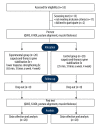Effects of Lower Trapezius Strengthening Exercises on Pain, Dysfunction, Posture Alignment, Muscle Thickness and Contraction Rate in Patients with Neck Pain; Randomized Controlled Trial
- PMID: 32202262
- PMCID: PMC7115121
- DOI: 10.12659/MSM.920208
Effects of Lower Trapezius Strengthening Exercises on Pain, Dysfunction, Posture Alignment, Muscle Thickness and Contraction Rate in Patients with Neck Pain; Randomized Controlled Trial
Abstract
BACKGROUND Neck pain is reported by many laborers who are at risk of experiencing musculoskeletal disorders due to muscle stiffness and hypokinetics. This study examined the effects of a lower trapezius exercise program on neck pain patients. MATERIAL AND METHODS The design of this study was a randomized controlled trial. A total of 40 neck pain patients participated in this study. Screening tests were performed and assigned to experimental group (n=20) and control group (n=20) using randomization program. Both groups underwent a scapula and thoracic spine stabilization exercise program. In addition, the experimental group implemented the lower trapezius strengthening exercise program. All interventions were applied 3 times per week for 4 weeks. Visual Analogue Scale (VAS), Neck Disability Index (NDI), postural alignment, muscle thickness and contraction rate were compared to evaluate the effect on intervention. RESULTS Both groups showed significant differences in VAS, NDI, and postural alignment before and after intervention (P<0.05). In addition, the experimental group showed more significant difference in the amount of change in NDI and postural alignment values than the control group. The experimental group showed significant improvement in muscle thickness and contraction (P<0.05). CONCLUSIONS A lower trapezius strengthening exercise program is an effective method with clinical significance for reducing the level of neck dysfunction, and improving the postural alignment, muscle thickness, and contraction rate of the lower trapezius muscle.
Conflict of interest statement
None.
Figures





References
-
- Hoving JL, De Vet HC, Twisk JW, et al. Prognostic factors for neck pain in general practice. Pain. 2004;110:639–45. - PubMed
-
- Kanchanomai S, Janwantanakul P, Pensri P, Jiamjarasrangsi W. Prevalence of and factors associated with musculoskeletal symptoms in the spine attributed to computer use in undergraduate students. Work. 2012;43:497–506. - PubMed
-
- Falla D, Jull G, Russell T, et al. Effect of neck exercise on sitting posture in patients with chronic neck pain. Phys Ther. 2007;87:408–17. - PubMed
-
- Jull G, Trott P, Potter H, et al. A randomized controlled trial of exercise and manipulative therapy for cervicogenic headache. Spine (Phila Pa 1976) 2002;27:1835–43. - PubMed

